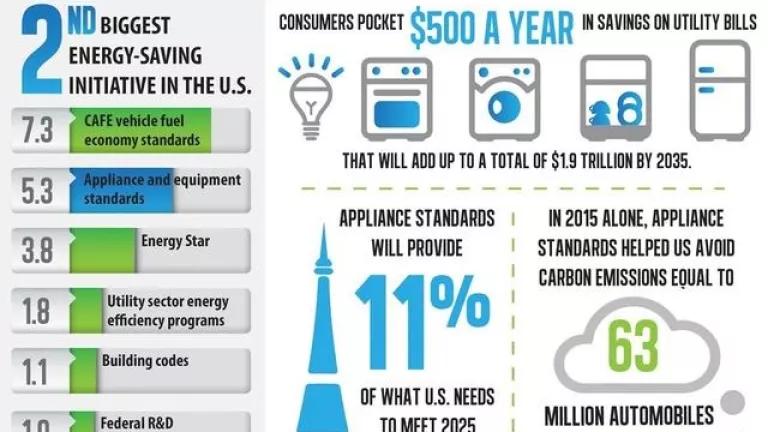
The Department of Energy’s (DOE) federal appliance standards program has provided decades of improved energy, environmental, and consumer benefits; and we still have more to achieve. And, as I told a congressional hearing today by all measures the program has been wildly representing the second-biggest energy savings policy in U.S. history, second only to vehicle fuel economy standards.
Increased energy efficiency in appliances reduces energy consumption and lowers utility bills, saving American households an average of $500 per year on utility bills—adding up to $63 billion in 2015 alone. Appliance standards aren’t just good for our wallets though; they also decrease energy consumption which means less pollution and cleaner air. In fact, national appliance standards helped the United States avoid 300 million tons of carbon dioxide emissions last year—the same amount of pollution that 63 million cars release into our air annually.
The fact of the matter is that every American is vulnerable to the health impacts of climate change, which is why President Obama made minimum efficiency standards a cornerstone of his Climate Action Plan. He set a goal of reducing carbon emissions by 3 billion metric tons by 2030 through minimum efficiency standards. We are well on our way to meeting that objective—standards already adopted during this administration will reduce carbon emissions by more than 2.2 billion metric tons with more savings on the way. Those are some big numbers and are amazing achievements—with still more room for improvement, which is what I emphasized in my testimony before the House of Representatives Committee on Energy and Commerce’s Subcommittee on Energy and Power. The Department of Energy’s Appliance and Equipment Standards Program sets dependable minimum efficiency levels that all Americans can count on.
NRDC has long supported cost-effective minimum standards and we are not alone. We’ve worked successfully alongside many groups, including three whose representatives also testified today: the National Electrical Manufacturers Association, the Association of Home Appliance Manufacturers, and the Air-Conditioning, Heating and Refrigeration Institute. These cost-effective efficiency standards are set in a way that not only saves consumers money and decreases pollution, it also allows manufacturers time to innovate—often improving technology beyond what we can imagine today. For example, in the early 2000s few predicted the revolution in lighting efficiency achieved with LED lightbulbs. But few actions can reduce the dangerous carbon pollution driving climate change as cheaply and easily as the simple act of replacing old-fashioned incandescent bulbs with today’s efficient models.
As I told the members of Congress today, making our appliances and equipment more energy efficient is the cheapest, cleanest, and fastest way to meet our power needs while also reducing climate-changing pollution. The energy saved through appliance standards last year was enough electricity to meet the needs of 43 million homes (that’s 1/3 of U.S. households) and enough natural gas to meet the heating needs of about 10 million U.S. homes. Those numbers will only grow as old equipment is replaced by new, more efficient appliances. We’ve had great and continued success with appliance standards and know that there are even more savings to be had to ensure a cleaner energy future for generations to come.


